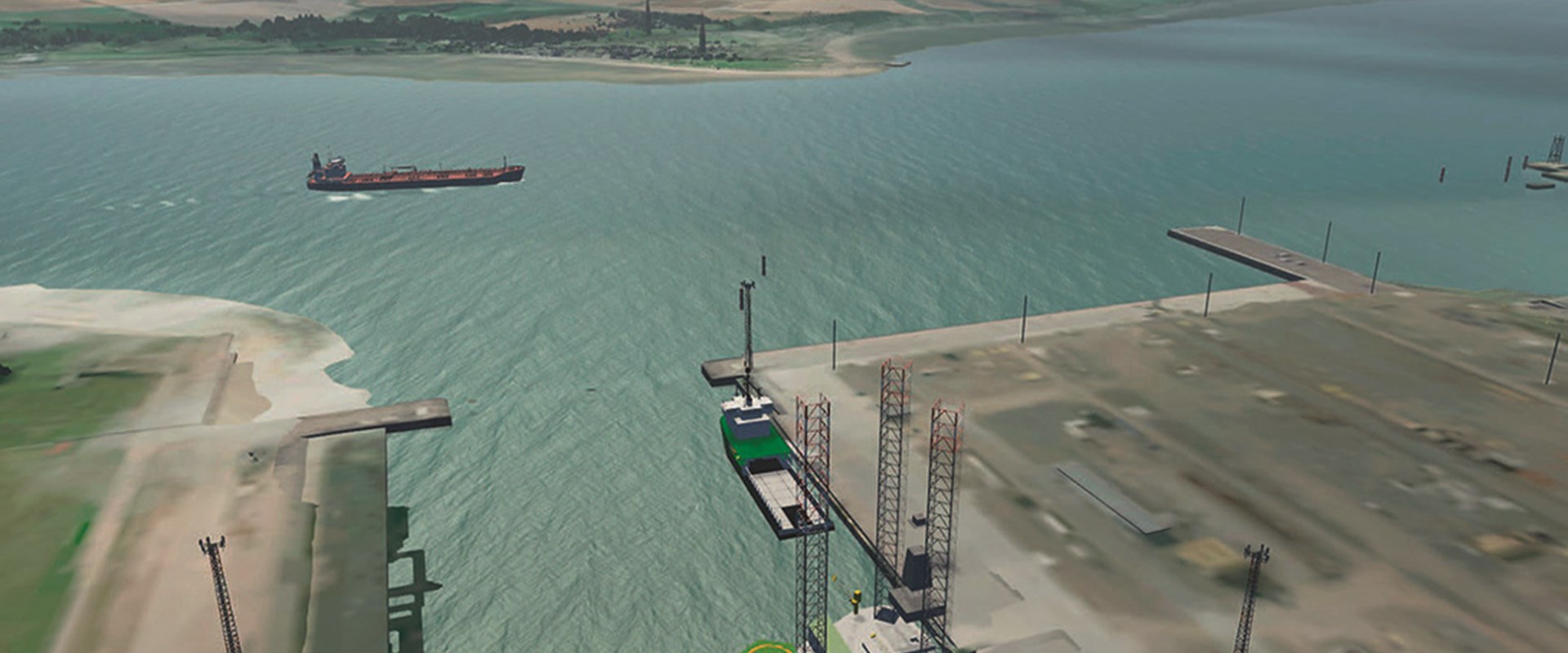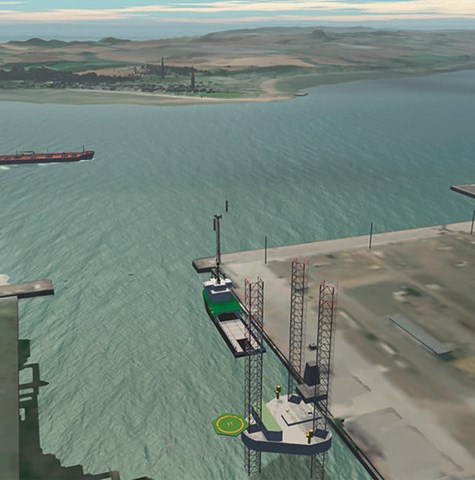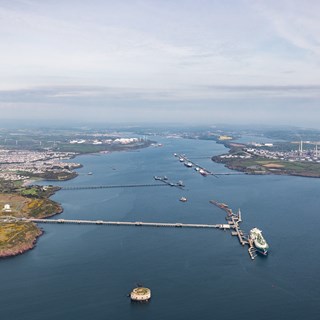
Future modelling
Building a port is a tough, expensive business, which can see investors struggle to hit the return on their investment. However, the latest generation of simulators is here to help.
17 July 2019
Inside a nondescript office building near Southampton, UK, lies the latest advance in port design. Down a corridor in a darkened room sits a ship’s bridge, complete with controls and screens to mirror real-life conditions, so sensitive that when P&H’s Jonathan Robins attempted to berth a container ship in a nice, safe port, with a little bit of weather to make it interesting, he felt distinctly queasy.
“Terminals, ports, floating oil and gas, floating LNG, anything that is of a significant potential investment offshore or on the ship-shore interface,” said Phil Thompson, director for simulation and training at UK-based engineering and technology firm BMT Global, rattling off a list of projects that its BMT REMBRANDT simulation technology has been used to model.
BMT REMBRANDT, which stands for real-time manoeuvering berthing and training, was originally designed in 1991 to mock-up berthing requirements for Dover-Calais operators P&O Ferries and Stena Sealink. By mathematically calculating real-life ocean conditions for wind, waves, currents, ship manoeuverability, and a myriad of other variabilities, BMT REMBRANDT, along with other simulation technology such as Kongsberg’s K-Sim, allows users to navigate and moor vessels, practice ship-to-ship transfers, or, by linking it with black box or AIS data, create visual 3D reconstructions of events, such as a marine accident. Other simulation providers, such as SimPlus, focus less on hydrodynamics and more on navigation and capacity.
However, simulators have another key use: port design. The same features that enable them to create ocean conditions, also allow them to simulate how ports will look, feel, and function in real life, and how vessels will use them. Such is the sophistication of the technology that simulators have become a key tool in the planning of new projects, enabling the changing of designs well before work begins on site.
“The simulator and the ships are a synthetic world, so you can do modifications to the port or even create a new port in the simulator to test all kinds of weather interactions or ship traffic,” said Terje Heirstad, vice-president of business development and Kongsberg.
“Simulators enable customers to save a lot of money in the early phase of a project because they can test out the design. With the simulator you get the look and feel of the project, you really are in the environment and you get a really good perception of what it will be like – and you can test them,” he told P&H.
Because the system calculates all the physical forces in the simulator – lines, ropes, frictions, tensions, and everything else, it is also, he insists, incredibly accurate. “It’s designed to measure all the hydrodynamic effects – pressure effects, shallow water effects, and others.”
A key priority for simulators involved in port planning is ensuring that the design will not limit the operability of the port, explained BMT’s Thompson. “When the port gets built, there should be nothing that was unexpected from the simulation.”
This also enables the system to examine how vessels will function in ports and under differing weather conditions. Because adverse weather gives vessels significant vertical motions, effectively seeing them bounce, modelling how they will behave under different conditions is critical for knowing dredging requirements and under keel clearance. “We usually simulate port designs with more challenging extreme weather envelopes, because if it works within the extreme weather its clearly going to be ok within calmer weather,” he noted.
Take a recent Nigerian greenfield port that BMT was involved with. “[The developers] came to us to explore the operational windows on a proposed new port layout in terms of channel design”, explained Thompson, with BMT REMBRANDT specifically looking at the issues of depth, channel approach, and vessel manoeuverability onto a berth – including the viability of accommodating different vessel types and sizes in a variety of weather conditions, as well as knowing their tug requirements. The dredging design for the Nigerian port was initially set around 17 m, “but the simulation was able to tell them that for arrival and departure, given changing weather conditions, unless they dredged deeper there would be quite a lot of downtime for the vessels that they plan on using”. To ensure the port would be operable 90% of the time, it would need to be dredged to a minimum of 20 m, at least in some places.
“BMT REMBRANDT enables ports to target their dredging requirements,” Thompson explained, “in some areas it can highlight the need for the bottom to be dredged to a greater depth, but in others it may demonstrate that less dredging is required”.
For the Nigerian greenfield port, the software also highlighted the inadequacy of an initial breakwater design, which was failing to absorb wave loadings, much of which was entering the port. The simulator could model this, and test out an improved breakwater. The end result was that as well as maximining the ports operability, the simulation will also allow its designers to incorporate cost savings. The influence of simulators can also be seen across other types of maritime projects. Kongsberg’s K-Sim, for example, was recently used to measure the impact of a river entering a new ship channel, enabling the designers to understand the size and number of tugs hat would be required to support large vessels in passing through the new channel.
SimPlus has been used heavily to plan for the dredging and reclamation work required to shift Singapore’s vast container terminal westward from the centre of the city, not only to see how the port will look like and function, but to ensure that dredging and construction work can be carried out safely in an area thick with marine traffic. Through modelling how vessels are likely to behave, becoming “the brain of the ship master and pilot”, the software was able to make several design recommendations to the port of Singapore’s plans, SimPlus’s Stuti Nautiyal told P&H.
But what could be simulators’ greatest impact on ports is perhaps yet to come. Kongsburg’s Heirstad notes that customers are increasingly using the technology to understand how autonomous vessels will behave in shared water spaces.
“Ports need to have the facility to support autonomous ships into the port, so some of our customers are running the prototypes of these processes,” he said.
BMT’s Thompson notes that fully autonomous vessels are unlikely to be occupying congested water spaces for another 20–30 years, but it is in this transition period, when manned and part-autonomous vessels are interacting with each other, that there will be uncertainty. And with uncertainty comes accidents.
Simulators can model how autonomous vessels will behave in shared water spaces, and how to navigate safely with them, by using the exact same software that is being developed for autonomous vessels. This opens up the possibility of vessels and simulators developing
in tandem. Simulators can even be used to train the artificial intelligence behind autonomous vessels how to behave in certain situations, or to, for example, recognise new marine objects. BMT REMBRANDT has already integrated with an autonomous vessel control system currently being deployed in UK water spaces.
“You’re going to have to train systems to recognise virtually anything in the water. But now what they do rather than having to tow sensors around in the water, they’re using BMT REMBRANDT,” Thompson said. Given the expected explosion in the use of automated vessels over the next few decades, the role and importance of simulatiors to ports, and the wider maritime industry, is only set to grow.
* This article was originally published in July/August 2019 Ports & Harbors
Editor Jonathan Robins


16 November 2023
We are proud to be awarded the contract of trusted technical support consultant for Port of Milford Haven. Providing independent governance and support throughout the vessel design, build, training, and trial phases.

9 October 2023
BMT in the UK and Europe has announced a new senior business development managerial appointment, effective this month, which will support the delivery of the company’s Marine Surveys’ strategy.

28 February 2023
• BMT’s Andrew Aldrich has been promoted to the role of Global Business Development Director – Infrastructure and Environment • The move highlights our concerted effort to align strong regional capabilities to global strategy in the energy and environment markets.

6 May 2022
As an experienced business leader, Graeme Nayler brings a track record of business transformation and growth that will benefit the BMT portfolio, with relevant industry experience in transport, infrastructure, environment, government and defence